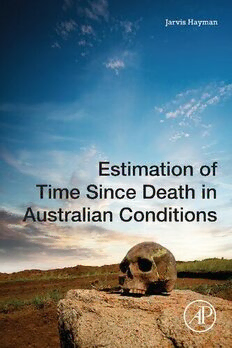
Estimation of Time since Death in Australian Conditions PDF
Preview Estimation of Time since Death in Australian Conditions
Estimation of Time Since Death in Australian Conditions This pageintentionallyleftblank Estimation of Time Since Death in Australian Conditions JARVIS HAYMAN MB,ChB, FRCS(Ed), FRACS, MA(Hons) Archaeology, PhD Australian National University, Canberra, ACT,Australia AcademicPressisanimprintofElsevier 125LondonWall,LondonEC2Y5AS,UnitedKingdom 525BStreet,Suite1650,SanDiego,CA92101,UnitedStates 50HampshireStreet,5thFloor,Cambridge,MA02139,UnitedStates TheBoulevard,LangfordLane,Kidlington,OxfordOX51GB,UnitedKingdom Copyright©2021ElsevierInc.Allrightsreserved. Nopartofthispublicationmaybereproducedortransmittedinanyformorbyanymeans, electronicormechanical,includingphotocopying,recording,oranyinformationstorageand retrievalsystem,withoutpermissioninwritingfromthepublisher.Detailsonhowtoseek permission,furtherinformationaboutthePublisher’spermissionspoliciesandour arrangementswithorganizationssuchastheCopyrightClearanceCenterandtheCopyright LicensingAgency,canbefoundatourwebsite:www.elsevier.com/permissions. Thisbookandtheindividualcontributionscontainedinitareprotectedundercopyrightby thePublisher(otherthanasmaybenotedherein). Notices Knowledgeandbestpracticeinthisfieldareconstantlychanging.Asnewresearchand experiencebroadenourunderstanding,changesinresearchmethods,professionalpractices, ormedicaltreatmentmaybecomenecessary. Practitionersandresearchersmustalwaysrelyontheirownexperienceandknowledgein evaluatingandusinganyinformation,methods,compounds,orexperimentsdescribed herein.Inusingsuchinformationormethodstheyshouldbemindfuloftheirownsafety andthesafetyofothers,includingpartiesforwhomtheyhaveaprofessionalresponsibility. Tothefullestextentofthelaw,neitherthePublishernortheauthors,contributors,or editors,assumeanyliabilityforanyinjuryand/ordamagetopersonsorpropertyasamatter ofproductsliability,negligenceorotherwise,orfromanyuseoroperationofanymethods, products,instructions,orideascontainedinthematerialherein. BritishLibraryCataloguing-in-PublicationData AcataloguerecordforthisbookisavailablefromtheBritishLibrary LibraryofCongressCataloging-in-PublicationData AcatalogrecordforthisbookisavailablefromtheLibraryofCongress ISBN:978-0-12-824424-1 ForInformationonallAcademicPresspublications visitourwebsiteathttps://www.elsevier.com/books-and-journals Publisher:StacyMasucci AcquisitionsEditor:ElizabethBrown EditorialProjectManager:MarianaL.Kuhl ProductionProjectManager: KiruthikaGovindaraju CoverDesigner:ChristianJ.Bilbow TypesetbyMPSLimited,Chennai,India Contents Acknowledgements ix Aboutthebook xi Introduction xiii 1. Areviewof research concerningthe estimation of time since death in decomposedbodies in the early stagesof decomposition 1 1.1 Immediatepost-mortemorsupravitalreactions 2 1.1.1 Livormortis 2 1.1.2 Rigormortis 4 1.2 Algormortisandtemperature-basedmethodsofestimatingthe post-morteminterval 5 1.2.1 Mid-20thcenturyresearch 7 1.2.2 Late20thand21stcenturyresearch 14 1.3 Biochemicalmethodsofexaminingbodytissuesandfluids 23 1.3.1 Chemicalinvestigationofvitreoushumor 24 1.3.2 Theestimationofhypoxanthineinvitreoushumor 34 1.3.3 Chemicalinvestigationofsynovialfluid 36 1.3.4 Biomarkersofthepost-mortemintervalinthebonemarrowand otherbodyorgans 36 1.3.5 Immunohistochemistry 37 1.3.6 High-resolutionprotonmagneticresonancespectroscopy 38 1.3.7 Electrolyteconcentrationsincerebrospinalfluid 38 1.3.8 Electrolyteconcentrationsinpericardialfluid 39 1.3.9 Theuseofdeoxyribonucleicacidandribonucleicacidinthe estimationofthepost-morteminterval 39 2. Areviewofresearchconcerningtheestimationoftimesincedeath indecomposedbodiesinthelaterstagesofdecomposition 41 2.1 EstimationofthePMIduringthestageofautolysisandearlyputrefaction 41 2.1.1 Extrinsicfactorsaffectingdecomposition:temperature,environment, insects,burial,moistureandscavenging 41 2.1.2 Delayeddecompositionandpreservation:mummificationand adipocereformation 43 2.2 EstimationofthePMIinthelaterstagesofputrefactionandskeletonisation 44 2.2.1 Forensicentomologyandtheestimationofthepost-morteminterval 44 2.2.2 EstimationofthePMIinskeletalremains 48 v vi Contents 2.3 Currentresearchandfuturedirections 55 2.3.1 Developmentofagradingsystemofhumandecomposition 56 2.3.2 CorrelationofadecompositiongradingsystemwiththePMI 57 2.3.3 Recentresearchandcurrenttrends 60 3. Materials andmethods 63 3.1 Materials 63 3.1.1 TheAustralianCoronialSystemandtheVictorianInstituteof ForensicMedicine 64 3.1.2 TheNationalCoronialInformationSystem:historyandorganisation 65 3.1.3 Qualityofreports 66 3.1.4 ThestatisticsrevealedbytheNCISdatabaseconcerning decomposedbodies 67 3.1.5 Commentsonthestatisticalfindings 70 3.2 Methods 73 3.2.1 Introduction 73 3.2.2 Theautopsyreport 74 3.2.3 Thesequentialstagesofdecompositionderivedfromautopsyreports 77 3.2.4 Developmentofadecompositiongradingscore 81 3.2.5 Correlationofthedecompositiongradingscorewith temperatureandhumiditydata 85 4. Modelling time since death 91 4.1 Introduction 91 4.2 Exploringthedatasets 92 4.2.1 Testingfornormalityofdistributionofthevariables 92 4.2.2 Homogeneityofvariance 93 4.3 Explorationofvariablecorrelations 95 4.4 Testingobservedcorrelations 98 4.5 Modellingtimesincedeath 101 4.5.1 Predictionoftheerrorintheoutcomevariable 103 4.5.2 Themathematicalequationofthemodel 103 4.5.3 Theassessmentofindividualpredictorsbythet-statistic(t) 104 4.5.4 Outliersandinfluentialcases 105 4.5.5 Theresultsofregressionanalysisoneachdataset 106 4.5.6 Multipleregressionanalysis 113 4.6 Fittedandobservedrelationships 121 4.7 ComparisonoftheExternalBodyScorewiththeTSD 125 4.8 Summary 128 4.9 Thefinalmodels 129 Contents vii 5. Practicalapplication of the models 131 5.1 Part1:Autopsyassessmentof13decomposedbodies 131 5.1.1 Introduction 131 5.1.2 Descriptionandanalysisof13decomposedbodies 132 5.1.2.1 Caseno.1:male(57) 132 5.1.2.2 Caseno.2:male(68) 135 5.1.2.3 Caseno.3:male(51) 137 5.1.2.4 Caseno.4:male(79) 139 5.1.2.5 Caseno.5:male(68) 142 5.1.2.6 Caseno.6:female(77) 143 5.1.2.7 Caseno.7:male(74) 144 5.1.2.8 Caseno.8:male(57) 147 5.1.2.9 Caseno.9:male(37) 148 5.1.2.10 Caseno.10:male(43) 151 5.1.2.11 Caseno.11:female(59) 153 5.1.2.12 Caseno.12:male(41) 155 5.1.2.13 Caseno.13:male(69) 158 5.1.3 Discussion 159 5.1.4 Conclusion 163 5.2 Part2:Monitoringtwodecomposingbodies 164 5.2.1 Introduction 164 5.2.2 Materialsandmethods 166 5.2.3 Results 168 5.2.3.1 Temperatureandhumiditydata 168 5.2.4 Thedecompositionprocess 171 5.2.4.1 Theautopsies 176 5.2.5 Discussion 183 5.2.5.1 Thetemperatureandhumiditydata 183 5.2.5.2 Thecontrastingdecompositionprocessesbetween BodyNo.1andBodyNo.2 184 5.2.6 Conclusion 189 6. Discussion andconclusions 191 6.1 Timesincedeath:problemswithaccuracy 191 6.1.1 TSDestimationintheearlystagebytheuseofacoolingformula 191 6.1.2 TSDestimationintheearlystagebybiochemicalmethods 192 6.1.3 TSDestimationinthestageofputrefaction:theroleofentomology 193 6.1.4 TSDestimation:thedevelopmentofanumericalgradingsystem 194 viii Contents 6.2 Thedataset 198 6.2.1 Temperature,humidityandtheenvironment 198 6.2.2 TotalBodyScore 203 6.2.3 Timesincedeath 206 6.2.4 Temperatureoftheinternalbodyorgans 206 6.3 Mathematicallymodellingtimesincedeath 207 6.3.1 Thecontributionoftemperatureandhumiditydatain modellingTSD 210 6.3.2 Thepracticaluseofthemodel:theassessmentof13decomposed bodies 212 6.4 Robustnessofthetimesincedeathmodellingandfutureresearch 212 6.5 Summaryandconclusion 214 References 219 Index 231 Acknowledgements The research while studying the NCIS Database and gaining access to observe autopsies of decomposed bodies at the VIFM in Melbourne was in no small way aided by the dedicated pathologists who work there and in particular to Professor David Ranson the Deputy Director of the Forensic Services Division at the VIFM. They have my grateful thanks for their assistance and knowledge. An Endeavour Research scholarship was awarded by the Australian Government in 2011 which enabled me to spend 2 months at the Grady Early Forensic Anthropology Laboratory and the Forensic Anthropology Research Facility (FARF) at Texas State University in San Marcos. The FARF is a 26-acre outdoor human decomposition research laboratory at Texas State’s Freeman Ranch and it is spatially the largest facility of its kind in the world. While there I was indebted to the many students and to Kyra Stull, then head of the FARF and now an Assistant Professor of Bioanthropology at the University of Nevada. I also shared many pleasant lunches with Emeritus Professor Grady Early and the students and will always be grateful for their kind hospitality. I owe grateful thanks to the staff at the School of Archaeology and Anthropology of the Australian National University for their friend- ship and help in allowing me the use of the facilities during my years there as a postgraduate student and Visiting Fellow. Lastly, my gratitude goes to Elizabeth Brown, Senior Acquisitions Editor and her staff at Elsevier for their help in publishing this thesis rather than have it languish- ing on a dusty University shelf. ix
